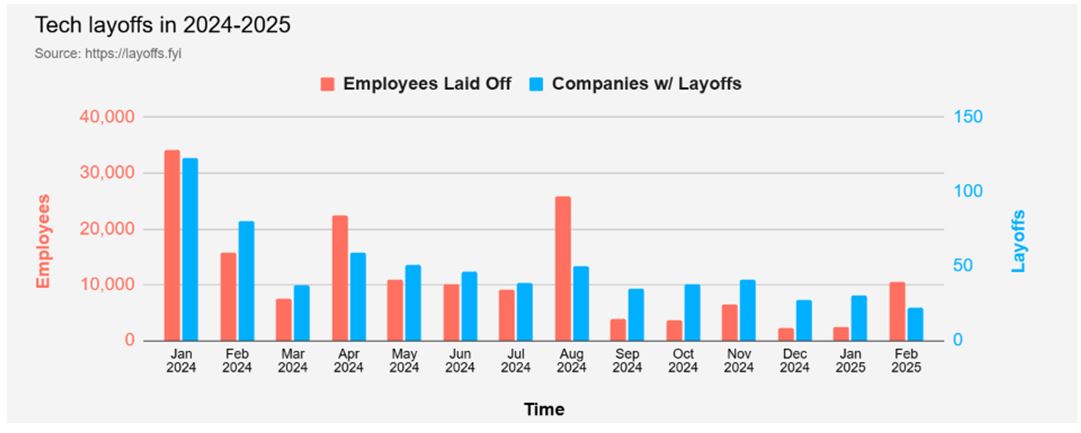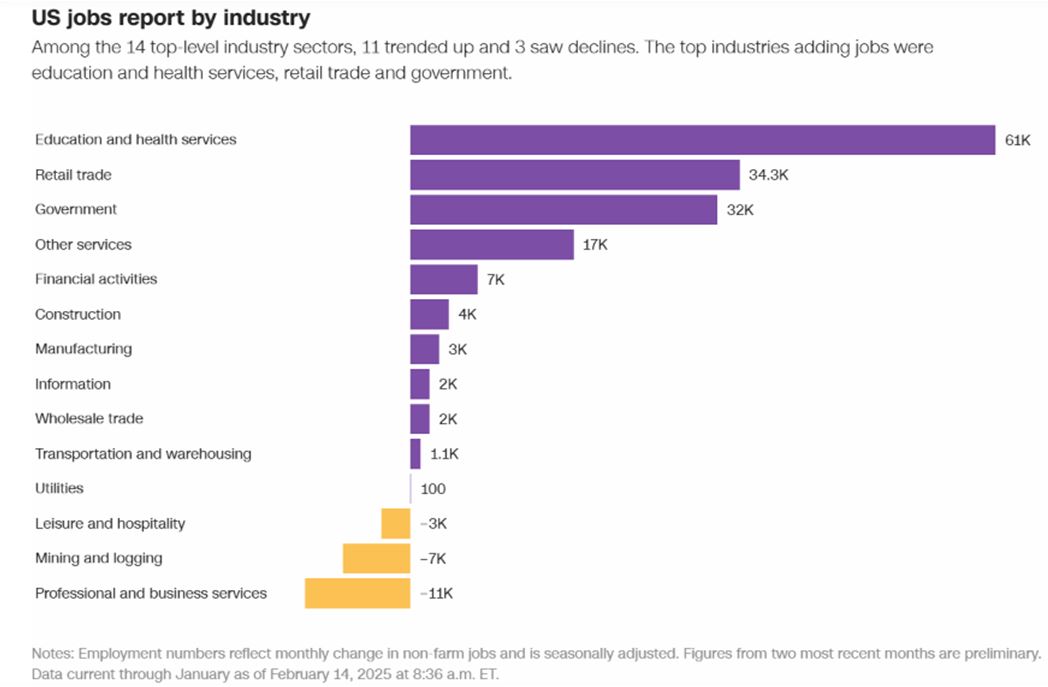by Bryan Perry
February 19, 2025
On February 7, it was reported that the U.S. economy kicked off 2025 by adding 143,000 jobs in January, fewer than expected (155,000), but the unemployment rate dipped to 4.0%, according to the Bureau of Labor Statistics (BLS). The three-month average for new non-farm payrolls increased to 237,000 from 204,000, as December payrolls were revised to 307,000 from 256,000 and November payrolls were revised to 261,000 from 212,000 coupled by a solid 0.5% monthly increase in average hourly earnings.
The takeaway from this report was that the labor market is quite healthy, but that’s only according to the government’s official BLS statistics, which have been found to be misleading in several large downward revisions in both 2024 and 2023. Skeptical investors who are suspicious of the veracity of these job numbers put out by the BLS seem to have some ground to stand on, as corroborated by a wave of very large and high-profile layoffs announced recently by many of America’s leading corporations.
The range of layoffs runs across industries. Last week, Chevron announced they will lay off 20% of their global workforce, or roughly 8,000 employees. BP announced layoffs of 7,700. Microsoft announced an undisclosed number of layoffs. Meta announced another round of layoffs, 5%, that comes to around 3,600 employees. Workday laid off about 1,750 employees, or 8.5% of staff, and Google is offering voluntary buyouts to workers in its platforms and devices units while Salesforce laid off 1,000 this month. And Estee Lauder announced this month they are slashing their workforce by 10% or 7,000 employees.
Graphs are for illustrative and discussion purposes only. Please read important disclosures at the end of this commentary.
The January employment report featured some significant data adjustments indicating that job growth last year was weaker than previously estimated. The latest revision showed that there were 589,000 fewer jobs added to the economy in 2024 than first stated. “That leaves us in a situation where things can essentially flip quite quickly, because you’ve already got companies hiring as if they’re in a recession — even if they’re not laying people off,” said Oliver Allen, senior U.S. economist at Pantheon Macroeconomics.
The latest wave of white-collar layoffs and restructuring reflects a significant shift towards leaner, more performance-driven organizations. Rather than casting a wide net that attracts the tech industry’s most talented workers, companies are sharpening their focus for AI jobs. As tech industry’s job cuts sweep through the workforce, roles in machine learning and engineering remain in high demand, signaling an aggressive approach towards precision-driven talent acquisition to build out AI systems and platforms.
The World Economic Forum’s January 2025 Insight Report, titled, “Future Jobs Report,” says that over 40% of companies worldwide are expecting to reduce their work-forces over the next five years, as part of the rising impact of artificial intelligence. But the wave of rising layoffs doesn’t stop with the tech sector. According to Intellizence, a Toronto-based AI consulting firm, over 5,700 companies announced mass layoffs in 2024, followed by 190+ more in early 2025. From large to small, no sector is being spared.
As industries pivot to producing more products and services with fewer employees, workers and businesses alike must adapt to survive. Governments and educational institutions will play a critical role in bridging the skills gap, while companies must balance innovation with ethical responsibility for re-training and transitioning existing employees to align with future work realities.
Graphs are for illustrative and discussion purposes only. Please read important disclosures at the end of this commentary.
- Transportation and Logistics: Since autonomous vehicles are becoming a trend in transportation, AI could replace 2.5 million driving jobs in upcoming years. This includes taxis, metros, and buses. Warehouse automation might displace 1.8 million workers.
- Retail: Some supermarkets or grocery stores are adopting self-checkout, which could eliminate 3.5 million positions. AI-powered inventory management might replace an additional 1.2 million jobs.
- Professional Services: The most affected jobs under professional services are legal research and accounting roles, led by automated accounting systems, with 900,000 jobs potentially affected and legal research automation, with 140,000 positions at risk (source: www.jobbright.ai).
In this light, what was most revealing in the BLS January jobs report was the breakdown of where the job growth was highest. Education, health services, government and retail trade accounted for 127,300 (89%) of the 143,000 additions, while the higher-paid professional and business sector witnessed the largest decline (11,000). It is safe to say that, given the backdrop of AI’s future impact on retail and the efforts of DOGE to shrink government and federal education jobs, those heady January totals are a thing of the past.
Graphs are for illustrative and discussion purposes only. Please read important disclosures at the end of this commentary.
The World Economic Forum estimates that 85 million worldwide jobs may be displaced by AI in 2025 alone. McKinsey Global Institute projects that 375 million jobs (14% of the global workforce) will require “re-skilling” by 2030. The AI boom is here and now, and this means that the job market is going to go through some real upheaval in 2025 and beyond. If the recent pace of layoffs from the S&P 500 and Global 1000 companies picks up speed, the notion of the Fed keeping rates higher for longer will quickly give way to a rapid change in monetary policy if – more likely when – the unemployment rate hits 5%.
Navellier & Associates, a few accounts own of Microsoft (MSFT), and Meta Platforms Inc Class A (META), per client request, we do not own Chevron (CHV). Bryan Perry does not own Microsoft (MSFT), Meta Platforms Inc Class A (META), or Chevron (CHV) personally.
The post 2-19-25: AI is Causing a Rising Wave of White-Collar Layoffs appeared first on Navellier.







